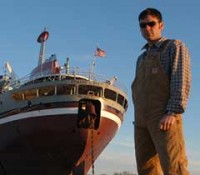
Keith Meverden – Banquet Speaker
Maritime Archaeologist with the Wisconsin Historical Society
Keith Meverden is a maritime archaeologist with the Wisconsin Historical Society, and has worked on projects throughout the US Virgin Islands, Wisconsin, and North Carolina, including the USS Monitor with the National Oceanic and Atmospheric Administration (NOAA). Keith’s primary interests include small Great Lakes sailing craft and the use of closed-circuit rebreathers in Great Lakes shipwreck exploration. His professional experience includes serving as a First Mate aboard the US Army’s 174-foot LCU2000-class landing craft in the Persian Gulf, a charter captain with a Master license, and a commissioned officer in the US Coast Guard Reserve.
The Apex of Wooden Shipbuilding: The Great Lakes Bulk Carrier Appomattox
The close of the nineteenth century bought with it the twilight of wooden ship building. Advances in steel ship construction eclipsed the wooden vessels in size, weight, and cost. Michigan shipbuilder Captain James Davidson, however, continued to not only build wooden vessels at a time when most shipyards were converting to steel, but pushed the accepted limits of wooden vessel construction while maintaining a competitive commercial edge.
In 1896, the Davidson shipyard launched the 319-foot Appomattox, the largest wooden steamer ever to ply the Great Lakes, and possibly the world. Following centuries of refinement in wooden ship construction, Davidson’s vessels were the product of the most advanced wooden technologies witnessed by the shipping industry. In 1905, blinded by heavy industrial smoke emanating from Milwaukee, the Appomattox ran hard aground north of the Milwaukee harbor entrance. Unable to be freed, the Appomattox was stripped and abandoned.
Today, the Appomattox lies in 20 feet of cold Lake Michigan water, with major hull sections well preserved. The remains of the Appomattox illustrate the apex of wooden ship construction techniques, incorporating the use of steel reinforcements to provide rigidity to flexible wooden hulls.
